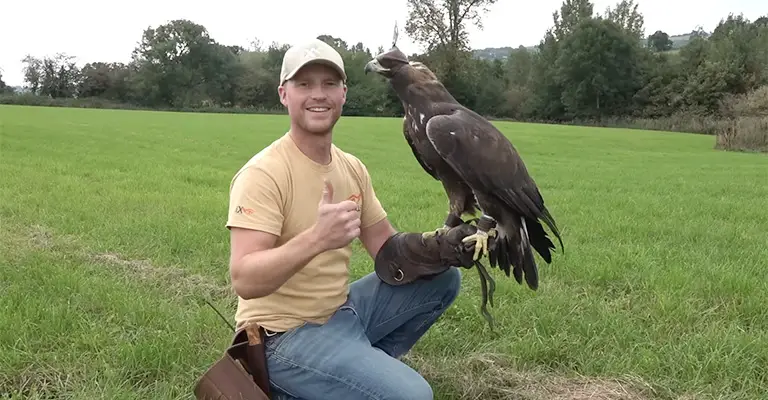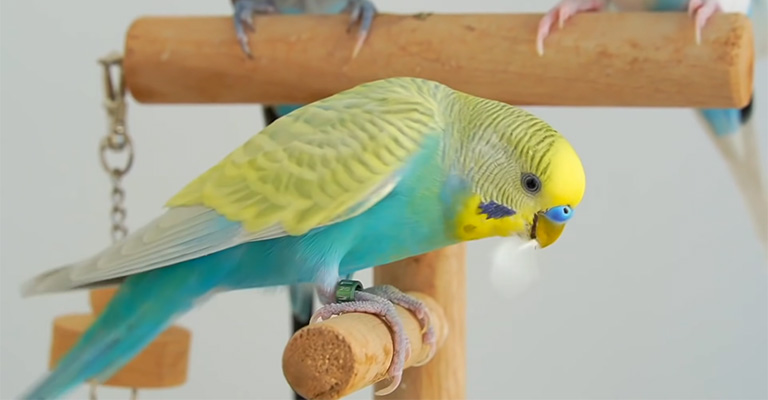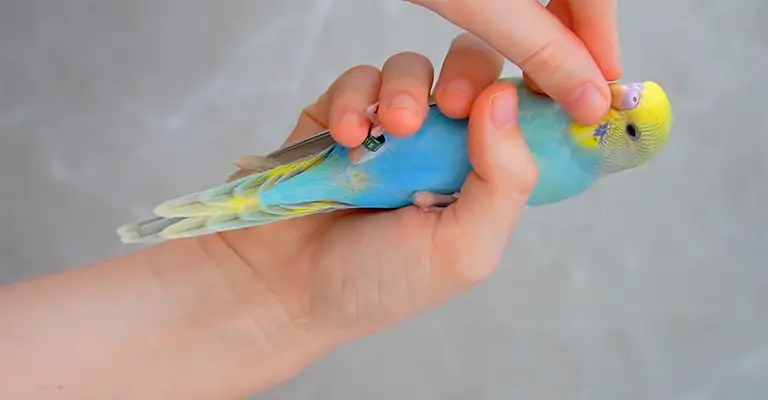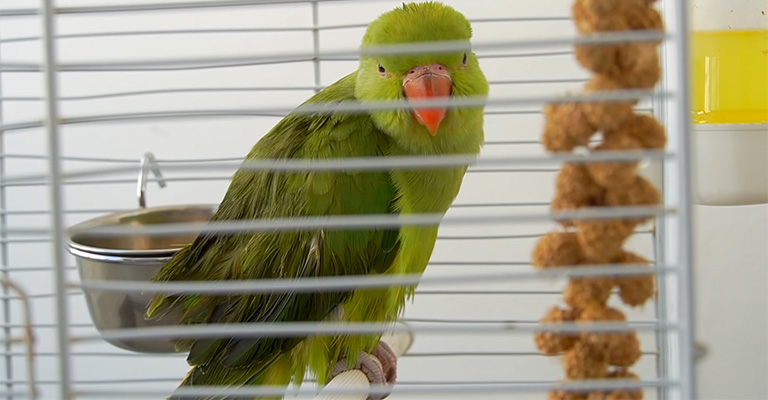As a cherished member of your household, your pet bird’s behavior is a window into its well-being and emotions.
One puzzling behavior that often raises concerns is pacing back and forth within its enclosure. While birds exhibit a range of natural behaviors, pacing can signal underlying physical or psychological factors that warrant attention.
If your bird is pacing excessively, it could indicate discomfort or pain related to health problems. Getting your bird evaluated by a veterinarian can help determine the underlying cause.
This article delves into ‘Why is my pet bird pacing back and forth’, shedding light on the potential reasons your pet bird engages in repetitive pacing. From environmental stressors to health issues, we explore the various factors that might contribute to this behavior.
By understanding the motivations behind your feathered companion’s actions, you can provide the care and comfort needed to ensure a happy and thriving avian friend.

Why Is My Pet Bird Pacing Back and Forth?
Birds are inherently expressive creatures, using their actions to communicate their needs and sentiments. Pacing behavior in pet birds can be indicative of several underlying factors that are important to comprehend.
Recognizing these cues and decoding their significance is crucial for responsible bird ownership. So, here are the reasons for this behavior:
Behavioral Insights and Avian Communication
Birds are more than just charming companions; they are eloquent communicators in their own right. The behavior they exhibit serves as a unique language that conveys their physical, emotional, and psychological states.
Pacing, among various behaviors, is one such form of communication that hints at deeper needs and emotions.
Environmental Stressors
Pacing often serves as an outlet for expressing discomfort caused by environmental stressors. Factors such as sudden loud noises, changes in routine, or the introduction of new pets or people can leave your bird feeling anxious and unsettled. Pacing may be their way of seeking refuge or attempting to regain a sense of control.
Boredom and Lack of Stimulation
Birds possess remarkable cognitive abilities and require mental stimulation to thrive. A lack of engaging activities or toys within their enclosure can lead to restlessness.
The pacing might emerge as an attempt to alleviate the monotony and seek outlets for mental energy.
Health Concerns

Pacing can be a subtle indicator of underlying health issues. Physical discomfort due to ailments such as pain, digestive problems, or respiratory difficulties could trigger the behavior.
It’s essential to closely monitor your bird for other signs of distress, including changes in appetite, weight loss, or unusual feather plucking.
Reproductive Behaviors
Certain bird species exhibit pacing as part of their natural reproductive behavior. This is particularly common among birds with strong nesting instincts. The pacing may indicate their readiness to lay eggs or establish a nesting territory.
Seeking Attention or Interaction
Some pet birds may resort to pacing as a way to grab their owner’s attention. If your bird has learned that pacing leads to a response from you, they might engage in this behavior to prompt interaction, playtime, or simply to be let out of their cage.
Territorial Behavior
In some cases, pacing might be linked to territorial instincts. If your bird perceives its enclosure as its territory and feels threatened by perceived intruders (such as other pets or even reflections), pacing could be an attempt to assert control over its space.
Hormonal Fluctuations
Hormonal changes, particularly during breeding seasons, can trigger pacing in some birds. Elevated hormone levels can lead to restlessness and a desire to engage in nesting behaviors, even if a suitable nesting site is unavailable.
Mimicking Natural Foraging Behavior
Pacing might mirror natural behaviors in the wild, such as foraging for food. In the absence of the need to search for sustenance, some pet birds may channel their natural instincts into repetitive pacing.
Response to Changes in Weather or Lighting
Birds are sensitive to changes in their environment, including fluctuations in lighting and weather conditions. Certain birds might pace in response to dim or bright lighting, changes in temperature, or atmospheric pressure shifts.
Social Interaction and Flock Dynamics
For social species of birds, pacing can sometimes be a way to communicate with other birds, even if they’re not physically present. Your bird might be responding to imagined interactions or attempting to connect with a perceived “flock.”
How to Prevent Pacing Behavior in Pet Birds?

Addressing and preventing pacing behavior in pet birds involves a comprehensive strategy that encompasses physical, mental, and emotional well-being.
Here’s how you can take a proactive approach to ensure your feathered companion’s happiness and reduce the likelihood of pacing:
Enriching Environment
Provide a stimulating and dynamic living space for your bird. Rotate toys regularly to prevent boredom, and introduce puzzle toys that encourage problem-solving and mental engagement. Offering a variety of perches, swings, and climbing structures can also keep your bird physically active.
Social Interaction
Spend quality time with your bird daily. Engage in interactive play, training sessions, and simply talking to your bird. This social interaction helps fulfill their need for companionship and mental stimulation, reducing the urge to pace.
Regular Exercise
Allow your bird to exercise outside of their cage daily, provided it’s safe and supervised. Flying or hopping around a designated area helps burn off excess energy and promotes physical health.
Balanced Diet
A nutritious and varied diet contributes to your bird’s overall well-being. Consult with an avian veterinarian to ensure your bird’s nutritional needs are met, as deficiencies can contribute to behavioral issues.
Consistent Routine
Establish a predictable daily routine for feeding, playtime, and rest. Birds thrive on routine, and knowing what to expect can reduce stress and anxiety that might trigger pacing.
Environmental Mimicry
Mimic natural lighting conditions by providing adequate exposure to natural sunlight during the day and dimming the lights during the evening. This helps regulate your bird’s internal clock and reduces stress.
Environmental Variety
Rotate cage placement or provide a change of scenery periodically. New views and surroundings can pique your bird’s interest and prevent monotony.
Avoid Stressors
Identify and minimize environmental stressors that could be triggering pacing. This might include loud noises, sudden changes, or the presence of other pets.
Mental Stimulation
Teach your bird tricks, introduce new commands, or even engage in clicker training. Mental challenges keep your bird engaged and prevent boredom-related behaviors.
Veterinary Care
Regular veterinary check-ups are essential to ensure your bird’s health. Discuss pacing behavior with your avian veterinarian to rule out any underlying medical issues.
Professional Guidance
If pacing persists despite your efforts, seek guidance from an avian behaviorist or experienced avian veterinarian. These professionals can offer tailored advice and interventions based on your bird’s specific needs.
How Do I Know If My Pet Bird Is Stressed?

Pet birds, while charming and delightful, can experience stress that impacts their health and happiness. Stress can cause your perbird to pace back and forth.
Recognizing the signs of stress is crucial for providing timely intervention and ensuring your feathered friend’s well-being. Here are key indicators to watch for:
Feather Picking or Plucking
Excessive preening, feather picking, or plucking can be a sign of stress. Birds may resort to these behaviors when they’re feeling anxious, bored, or overwhelmed.
Aggressive Behavior
Uncharacteristic aggression, biting, or attacking can signify that your bird is feeling threatened, scared, or stressed. This behavior may also be a response to changes in their environment.
Vocalizations
Changes in vocalizations, such as increased screaming, squawking, or persistent loud noises, might signal that your bird is distressed or trying to communicate its discomfort.
Changes in Appetite
A sudden change in eating habits—either a loss of appetite or increased consumption—can indicate stress. Stress may lead to digestive issues, affecting your bird’s eating patterns.
Body Language
Observe your bird’s body language. Fluffing up feathers, hunching, or sitting at the bottom of the cage can all be signs of distress. A visibly stressed bird might also exhibit trembling or shaking.
Excessive Pacing
Just as pacing back and forth can be a response to stress, it’s also a sign of stress itself. If your bird is displaying repetitive pacing, it’s crucial to address the underlying issue.
Reduced Activity
If your typically active bird becomes unusually lethargic or spends more time sitting quietly, it could be an indication of stress.
Changes in Sleep Patterns
Stress can disrupt sleep patterns. If your bird is sleeping more than usual or struggling to sleep, it might be a sign of underlying stressors.
Changes in Grooming Habits
Stress can lead to excessive grooming or, conversely, neglecting grooming altogether. Look for signs of scruffy or unkempt feathers.
Feather Fluffing
While birds do fluff up their feathers occasionally to regulate body temperature, excessive or prolonged fluffing might signal discomfort or stress.
Unusual Agitation
Restlessness, restlessly pacing, or constantly moving around the cage can indicate heightened anxiety or discomfort.
Avoidance Behavior
Birds that are stressed may try to hide, avoid interaction, or seek refuge in the corners of their cage.
FAQs
Occasional pacing might be considered normal behavior for pet birds, especially if they are exploring their environment or adjusting to changes.
However, excessive or constant pacing is often a cause for concern, as it could indicate underlying issues that need attention.
To help your bird stop pacing, it’s important to provide them with various forms of mental stimulation. This can be achieved through a combination of toys, social interaction, a consistent daily routine, and a safe environment.
While occasional pacing might not always require medical attention, if the behavior persists or is accompanied by other unusual behaviors, it’s advisable to consult an avian veterinarian. Avian veterinarians can assess whether the pacing is a sign of an underlying medical or psychological issue.
Yes, pacing in pet birds can indeed be a sign of illness. Birds, like any animals, can’t communicate their discomfort or pain in the same way humans can, so pacing might be their way of showing that something is wrong.
Certainly, changing the setup of your bird’s cage can play a significant role in reducing pacing tendencies. A well-designed cage should include a variety of perches at different heights and textures to encourage movement and foot exercise.
Bottom Line
In the intricate tapestry of avian behavior, pacing serves as a valuable clue that your pet bird is communicating its needs. Your pet bird’s pacing behavior serves as a window into its inner world, providing valuable clues about its emotional and physical state.
By observing its environment, addressing potential stressors, and consulting with avian experts if necessary, you can help alleviate any discomfort your bird might be experiencing.
Remember, a content and healthy bird thrives in an environment that accommodates its physical, mental, and emotional well-being. Understanding your bird’s behavior requires patience and observation.
If you’re concerned about your bird’s pacing or any other behavior, seeking professional advice from an avian veterinarian is always a wise decision.
By nurturing a deep understanding of your pet’s behaviors and needs, you’re not only fostering a stronger bond but also creating an enriching and fulfilling life for your feathered companion.